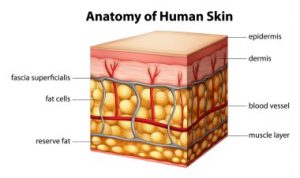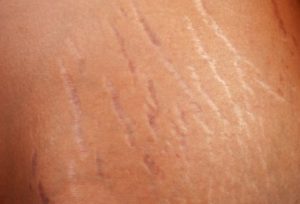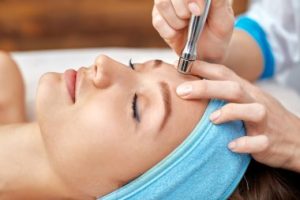
Can Exercise Get Rid Of Stretch Marks (6 Important Facts)
Can exercise get rid of stretch marks? It’s a question that tantalizes fitness enthusiasts and beauty seekers alike. Stretch marks, those silvery lines that map the journeys of growth, weight fluctuations, and pregnancy, often feel like unwelcome souvenirs on our skin. But what if the answer to fading these stubborn streaks lies not in expensive creams or invasive treatments, but in the very activities that enhance our health and vitality? Imagine transforming your body while potentially diminishing those marks that tell the tales of your life’s transitions. Dive in as we explore whether your next workout could be the key to smoother, more resilient skin.

Can Exercise Get Rid Of Stretch Marks
Exercise alone cannot completely get rid of stretch marks. Stretch marks, also known as striae, are a form of scarring on the skin caused by rapid stretching of the skin, often due to pregnancy, weight gain, or growth spurts. While exercise can improve skin elasticity, tone muscles, and reduce body fat, it cannot erase these scars. However, incorporating a consistent fitness routine can enhance overall skin health and appearance, making stretch marks less noticeable.
Understanding Stretch Marks
Stretch marks, medically termed striae, occur when the skin is stretched rapidly. This rapid expansion can cause the collagen and elastin in the skin to rupture, leading to the formation of these visible lines. Commonly associated with pregnancy, puberty, and significant weight changes, stretch marks can appear anywhere on the body but are most frequent on the abdomen, thighs, hips, breasts, and upper arms.
The Role of Exercise in Skin Health
Exercise plays a crucial role in maintaining overall skin health. Regular physical activity boosts circulation, which enhances the delivery of oxygen and nutrients to the skin, promoting a healthy and radiant appearance. Increased blood flow helps nourish skin cells and keep them vital. Additionally, exercise helps manage body weight, reducing the chances of rapid skin stretching that leads to stretch marks.
Muscle Toning and Skin Tightening
Strength training and resistance exercises are particularly beneficial for toning muscles and tightening the skin. While they won’t eliminate stretch marks, they can improve the underlying muscle structure, making the skin appear firmer and smoother. This can reduce the prominence of stretch marks, giving the skin a more even and toned look. Core exercises in particular, can help tighten the skin around the abdomen, where stretch marks are often most visible.
Hydration and Skin Elasticity
Hydration is key to maintaining skin elasticity. Drinking plenty of water and eating a balanced diet rich in vitamins and minerals support skin health from the inside out. While exercise helps with overall hydration by encouraging regular water intake, combining it with a nutritious diet can further enhance skin elasticity and resilience, making it less prone to developing new stretch marks.
Combining Exercise with Other Treatments
For those looking to reduce the appearance of stretch marks, combining exercise with other treatments may be more effective. Topical treatments like retinoid creams, hyaluronic acid, and laser therapy can help fade stretch marks over time. Exercise complements these treatments by improving skin tone and overall health, potentially accelerating the results.
Understanding Stretch Marks
Anatomy of Skin
Understanding stretch marks requires an appreciation of the skin’s anatomy and the roles of collagen and elastin. The skin comprises three main layers: the epidermis, dermis, and hypodermis. The outermost layer, the epidermis, acts as a protective barrier against environmental damage and pathogens. Beneath the epidermis lies the dermis, which is rich in connective tissue and houses structures such as blood vessels, hair follicles, and sweat glands.
The dermis is particularly crucial in the context of stretch marks because it contains collagen and elastin fibers, which provide the skin with strength and elasticity. Collagen, a protein, gives the skin its structural integrity, while elastin allows the skin to return to its original shape after stretching or contracting. The deepest layer, the hypodermis, consists mainly of fat and connective tissue, acting as insulation and cushioning for the body. Stretch marks, or striae, occur when the skin is stretched rapidly due to growth spurts, weight gain, pregnancy, or other factors.
This rapid stretching can exceed the elastic limits of the dermal layer, leading to the disruption of collagen and elastin fibers. When these fibers break, the skin’s normal structure is compromised, resulting in the formation of scars that we recognize as stretch marks. Initially, they appear as red or purple lines due to blood vessels showing through the torn dermal tissue, but over time, they often fade to a silvery-white color as blood flow diminishes and the affected area undergoes a healing process. Understanding the anatomy of the skin and the vital roles of collagen and elastin highlights the complexity behind the formation of stretch marks and underscores the challenges involved in their prevention and treatment.

Formation of Stretch Marks
Understanding the formation of stretch marks involves delving into the intricate processes of dermal tearing and subsequent healing. Stretch marks, scientifically known as striae, primarily form when the dermis, the skin’s middle layer, experiences rapid stretching. This stretching can occur due to various factors such as significant weight gain, pregnancy, growth spurts during puberty, or rapid muscle growth from intensive bodybuilding.
The dermis is home to collagen and elastin fibers, which provide structural support and elasticity to the skin. When the skin stretches too quickly, these fibers can break, leading to microscopic tears in the dermis. This tearing disrupts the normal structure and function of the skin, causing the characteristic linear scars. Initially, these tears expose underlying blood vessels, giving fresh stretch marks a reddish or purplish hue. Over time, as the skin attempts to heal itself, the body generates new collagen fibers.
However, this newly formed collagen is often arranged haphazardly rather than in the original structured network. The healing process results in scar tissue that has a different texture and appearance compared to the surrounding skin. As the scar tissue matures, the color of stretch marks typically fades to a silvery-white or flesh-toned shade, although the marks often remain slightly raised or indented.
The ability of the skin to heal and the eventual appearance of stretch marks can be influenced by several factors, including genetics, skin type, and overall health. Understanding the formation of stretch marks underscores the complexity of skin biology and highlights why these marks can be difficult to treat or prevent completely.

Types of Stretch Marks
Stretch marks, or striae, manifest in different forms depending on their stage of development and coloration, primarily categorized as red/purple stretch marks (striae rubrae) and white/silver stretch marks (striae albae). Striae rubrae represent the initial phase of stretch mark formation, characterized by their reddish or purplish hue.
This vivid coloration is due to the underlying blood vessels that become visible through the tears in the dermis. At this stage, the marks are fresh, and the skin may also exhibit signs of inflammation, such as itching or slight discomfort. Striae rubrae are more responsive to treatment and have a higher likelihood of fading with interventions such as topical creams, laser therapy, and other dermatological procedures aimed at promoting skin regeneration and collagen production.
Over time, if left untreated or as the natural healing process progresses, these red or purple marks gradually transition into striae albae. Striae albae are older stretch marks that have lost their initial pigmentation and appear white or silvery. This change occurs as the blood vessels contract and the inflammation subsides, leaving behind scar tissue composed primarily of disorganized collagen fibers. These mature stretch marks are typically more challenging to treat, as the skin has already undergone significant structural changes.
The texture of striae albae is often different from the surrounding skin, feeling slightly depressed or raised, and their appearance is more permanent. Treatments for striae albae focus on improving skin texture and stimulating collagen production, but complete removal is often difficult. Understanding the different types of stretch marks, from the early, more treatable striae rubrae to the more resilient striae albae, highlights the importance of early intervention and the complexities involved in managing these common skin changes.
Role of Exercise in Skin Health
General Benefits of Exercise
Exercise plays a crucial role in maintaining and improving skin health, offering a myriad of benefits that extend beyond just physical fitness. One of the primary advantages of regular exercise is improved blood circulation. Enhanced circulation ensures that oxygen and essential nutrients are delivered more efficiently to skin cells, promoting healthier skin by facilitating cell regeneration and repair. This increased blood flow also aids in the removal of toxins and waste products from skin cells, contributing to a clearer, more radiant complexion.
Additionally, exercise helps to enhance muscle tone, which in turn supports the skin. As muscles become more toned and firm, they provide better structural support to the overlying skin, reducing the appearance of sagging and contributing to a more youthful appearance. This toning effect is particularly beneficial for areas prone to laxity, such as the face, neck, and upper arms.
Moreover, exercise stimulates the production of collagen, a vital protein that maintains skin elasticity and firmness, helping to prevent the formation of fine lines and wrinkles. Beyond these direct skin benefits, exercise significantly contributes to overall health and well-being, which indirectly impacts skin health. Regular physical activity helps to manage stress levels, which can reduce the occurrence of stress-related skin conditions such as acne, eczema, and psoriasis.
Exercise also boosts the immune system, aiding in the body’s ability to fight off infections and inflammation that can affect the skin. Furthermore, maintaining a healthy weight through exercise can help prevent the formation of stretch marks and other skin issues related to rapid weight changes. The endorphin release associated with physical activity promotes a sense of well-being and can lead to better sleep patterns, both of which contribute to healthier, more vibrant skin.
Can Exercise Directly Get Rid of Stretch Marks?
Misconceptions About Exercise and Stretch Marks
There are common misconceptions surrounding whether exercise can directly eliminate stretch marks, often leading to confusion about its effectiveness in treating them. One prevalent myth is that targeted exercises, such as abdominal crunches or thigh exercises, can directly reduce or eliminate stretch marks in those areas.
However, the reality is that while exercise offers numerous benefits for overall health and skin tone, it cannot specifically target or eliminate stretch marks. Stretch marks form deep within the dermis due to rapid stretching that exceeds the skin’s elasticity, causing collagen and elastin fibers to tear. Once these fibers are damaged, they do not readily revert to their original state through exercise alone.
While regular exercise can help improve muscle tone and promote better circulation, which indirectly supports skin health, it does not directly affect the underlying structural changes that cause stretch marks. Another misconception is that increasing muscle mass through strength training can stretch the skin and worsen the appearance of stretch marks.
However, moderate strength training under proper guidance typically promotes gradual muscle growth without excessively stretching the skin beyond its limits. Moreover, some believe that sweating during exercise can help detoxify the skin and reduce the visibility of stretch marks, but sweat primarily regulates body temperature and does not directly affect stretch marks’ appearance.
Ultimately, while exercise is beneficial for overall health and can indirectly contribute to skin health and tone, it does not provide a direct solution for eliminating stretch marks. Effective treatments for stretch marks often involve dermatological interventions such as topical creams, laser therapy, microdermabrasion, or other cosmetic procedures aimed at stimulating collagen production and improving skin texture. Understanding these misconceptions helps clarify the role of exercise in skin care and highlights the importance of comprehensive approaches to managing stretch marks.
Limitations of Exercise
Exercise, while beneficial for overall health and fitness, has limitations when it comes to addressing certain skin concerns, such as stretch marks. One significant limitation is its inability to remove scar tissue once stretch marks have formed. Stretch marks are essentially scars that develop when the skin’s collagen and elastin fibers tear due to rapid stretching. Once these fibers are damaged, exercise cannot reverse or repair the underlying structural changes that have occurred. While exercise can promote better circulation and muscle tone, which indirectly supports skin health, it cannot eliminate the permanent nature of stretch marks.
These marks typically fade over time and may become less noticeable, but their presence remains as a testament to the skin’s previous stretching beyond its natural elasticity. Effective treatments for stretch marks often involve specialized dermatological procedures or cosmetic treatments aimed at improving skin texture and stimulating collagen production, acknowledging that exercise alone cannot alter the permanent nature of these skin imperfections. Understanding these limitations underscores the importance of seeking appropriate medical advice and treatments for managing stretch marks effectively.
Complementary Approaches to Managing Stretch Marks
Skincare Products
Complementary approaches to managing stretch marks often involve the use of skincare products that can help improve skin texture and appearance. Moisturizers play a crucial role in maintaining skin hydration, which can enhance elasticity and reduce the visibility of stretch marks. Keeping the skin well-hydrated with moisturizers containing ingredients like hyaluronic acid or cocoa butter can help improve its overall texture and suppleness.
Retinoids, such as tretinoin (retinoic acid), are another effective topical treatment option for stretch marks. Retinoids work by promoting collagen production and accelerating cell turnover, which can help reduce the appearance of stretch marks over time. Additionally, creams enriched with vitamins E and C are often recommended for their antioxidant properties, which can help protect the skin from free radical damage and support collagen synthesis.
Medical and Cosmetic Treatments
Medical and cosmetic treatments for stretch marks include a variety of procedures aimed at reducing their appearance and improving skin texture. Laser therapy is a popular option that uses focused light to stimulate collagen production and promote skin regeneration, effectively reducing the visibility of stretch marks.
Microdermabrasion involves exfoliating the skin with tiny crystals to remove the outer layer, enhancing skin texture and reducing the prominence of stretch marks. Microneedling, on the other hand, employs fine needles to create micro-injuries in the skin, which triggers the body’s natural healing response and boosts collagen production, leading to smoother skin.
Chemical peels use a combination of acids to remove the damaged outer layers of skin, promoting the growth of new, healthier skin and diminishing the appearance of stretch marks. Each of these treatments can be tailored to individual needs and skin types, providing a range of options for those seeking to improve the look of their skin.

Lifestyle and Dietary Considerations
A balanced diet, hydration, and avoiding rapid weight changes are crucial aspects of maintaining a healthy lifestyle. A balanced diet provides essential nutrients by including a variety of foods from all food groups, ensuring the body receives vitamins, minerals, proteins, carbohydrates, and fats necessary for optimal functioning.
Hydration is equally important, as water is vital for digestion, nutrient absorption, temperature regulation, and overall cellular function. Drinking adequate amounts of water throughout the day helps maintain these processes efficiently. Avoiding rapid weight changes is also essential, as sudden fluctuations can strain the body, disrupt metabolic balance, and lead to various health issues, including muscle loss, nutritional deficiencies, and increased risk of chronic diseases. Emphasizing these considerations fosters long-term health and well-being.
Practical Exercise Recommendations for Skin Health
Types of Exercises
Practical exercise recommendations for skin health encompass a balanced approach involving cardiovascular exercises, strength training, and flexibility/stretching routines. Cardiovascular exercises, such as running, cycling, and swimming, boost circulation and increase blood flow, delivering essential nutrients and oxygen to the skin cells while aiding in the removal of toxins.
This enhanced circulation helps to maintain a healthy and vibrant complexion. Strength training, including weight lifting and resistance exercises, supports overall body toning and muscle health, which indirectly benefits the skin by improving its elasticity and firmness.
Additionally, strength training promotes the release of growth hormones that can enhance skin repair and regeneration. Flexibility and stretching exercises, like yoga and Pilates, not only help in relieving stress, which can significantly impact skin health, but also improve circulation and muscle tone, contributing to a radiant and youthful appearance. Incorporating these types of exercises into a regular fitness routine can provide comprehensive benefits for maintaining healthy, glowing skin.
Exercise Routines
Engaging in regular physical activity can significantly benefit your skin’s health by promoting better circulation, reducing stress, and supporting overall wellness. A sample weekly exercise routine for optimal skin health could include a mix of aerobic exercises, strength training, and flexibility workouts. For instance, you might aim for 30 minutes of brisk walking or jogging on Monday, Wednesday, and Friday to boost circulation and oxygenate skin cells.
On Tuesday and Thursday, include 20-30 minutes of strength training exercises, such as weight lifting or resistance band workouts, to build muscle and improve skin firmness. Finally, dedicate Saturday to a yoga or pilates session to enhance flexibility and reduce stress, which can be beneficial for skin health.
Sunday can be a rest day to allow your body to recover. To maintain consistency in your exercise routine, set realistic goals, schedule workouts at the same time each day, and find activities you enjoy to stay motivated. Tracking your progress and partnering with a friend or joining a fitness group can also provide the necessary encouragement to keep up with regular exercise.
Combining Exercise with Skincare
Practical exercise recommendations for skin health should integrate effective workout routines with a diligent skincare regimen to ensure optimal results. Pre-workout, it is crucial to cleanse the skin to remove makeup, dirt, and impurities that could clog pores during exercise. Applying a lightweight, non-comedogenic sunscreen can protect the skin from UV damage, especially if exercising outdoors.
Post-workout, promptly cleansing the skin again helps remove sweat and bacteria, reducing the risk of breakouts. Using a gentle cleanser followed by a hydrating moisturizer can replenish the skin. Hydration plays a vital role; drinking adequate water before, during, and after exercise maintains skin elasticity and prevents dryness.
Nutrition also impacts skin health significantly; consuming a balanced diet rich in antioxidants, vitamins, and minerals supports skin repair and regeneration. Incorporating foods high in omega-3 fatty acids, such as fish and flaxseeds, can further enhance skin health by reducing inflammation and promoting a healthy complexion. By combining exercise with a thoughtful skincare routine, individuals can maintain glowing, healthy skin while reaping the numerous benefits of physical activity.
Frequently Asked Questions (FAQ) About Can Exercise Get Rid Of Stretch Marks
Q1: Can exercise completely eliminate stretch marks?
A1: Exercise alone cannot completely eliminate stretch marks. While it can improve overall skin health and appearance, stretch marks are a form of scar tissue that typically require additional treatments for significant reduction.
Q2: How does exercise help with the appearance of stretch marks?
A2: Exercise helps by boosting circulation and promoting healthy skin through increased collagen production. Strength training can also improve muscle tone, which may make stretch marks less noticeable by tightening the skin.
Q3: Are there specific exercises that are more effective for reducing stretch marks?
A3: While no specific exercise targets stretch marks directly, a combination of cardio and strength training can improve skin elasticity and muscle tone, indirectly aiding in the reduction of their appearance.
Q4: Can losing weight through exercise make stretch marks worse?
A4: Rapid weight loss or gain can exacerbate stretch marks. Gradual weight loss combined with regular exercise is less likely to worsen stretch marks and may help in their reduction.
Q5: How can I maximize the benefits of exercise for my stretch marks?
A5: To maximize the benefits, combine exercise with a healthy diet rich in vitamins A, C, and E, and stay hydrated. Additionally, using topical treatments like creams or oils specifically designed for stretch marks can enhance results.
Q6: Are there any exercises to avoid if I have stretch marks?
A6: There are no specific exercises to avoid, but it’s essential to maintain proper form and avoid rapid, excessive weight gain or loss to prevent further skin stretching.
Q7: Can exercise prevent new stretch marks from forming?
A7: Exercise can help maintain a healthy weight and improve skin elasticity, which may reduce the risk of developing new stretch marks. However, factors like genetics and hormonal changes also play a significant role.
Q8: Should I combine exercise with other treatments for stretch marks?
A8: Yes, combining exercise with treatments like laser therapy, microdermabrasion, or topical retinoids can provide more comprehensive results in reducing the appearance of stretch marks.
Q9: How long will it take to see improvements in my stretch marks from exercise?
A9: Results vary depending on factors such as skin type, severity of stretch marks, and consistency of your exercise routine. Generally, you may start to see improvements in skin tone and texture within a few months.
Q10: Are there any risks associated with using exercise to reduce stretch marks?
A10: Exercise itself poses minimal risk if done correctly and safely. However, overexertion or improper techniques can lead to injuries. Always follow a balanced routine and consult with a fitness professional if needed.
Conclusion
Exercise alone cannot entirely get rid of stretch marks, but it can play a supportive role in improving their appearance. Regular physical activity helps maintain a healthy weight, which can prevent new stretch marks from forming due to rapid weight changes. Exercise also promotes better circulation and skin elasticity, which can aid in the healing process and make stretch marks less noticeable over time. However, for more significant reduction, it is often necessary to combine exercise with other treatments such as topical creams, laser therapy, or microdermabrasion. Overall, while exercise is beneficial for overall skin health, it should be viewed as part of a comprehensive approach to managing stretch marks.